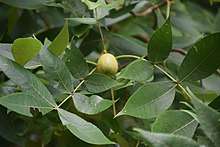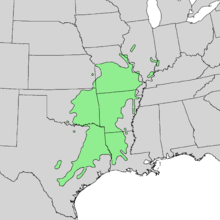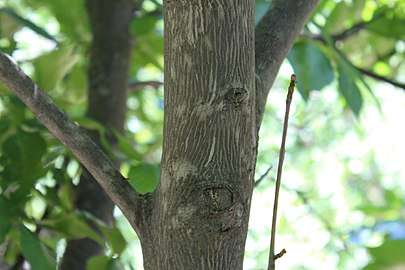Carya texana
Carya texana, or black hickory, for its dark colored bark, is a North American tree in the walnut family, Juglandaceae. It is endemic to the United States, found primarily in the southern Great Plains and the Lower Mississippi Valley.[2][3] It is an endangered species in Indiana, where it occurs in the southwest corner of the state.[2]
| Black hickory | |
|---|---|
 | |
| Scientific classification | |
| Kingdom: | Plantae |
| Clade: | Tracheophytes |
| Clade: | Angiosperms |
| Clade: | Eudicots |
| Clade: | Rosids |
| Order: | Fagales |
| Family: | Juglandaceae |
| Genus: | Carya |
| Section: | Carya sect. Carya |
| Species: | C. texana |
| Binomial name | |
| Carya texana Buckley (1861) | |
 | |
| Natural range of Carya texana | |
| Synonyms[1] | |
|
List
| |
Description
Black hickory grows up to 41 m (135 ft) tall. It has dark gray to black bark with a tight "diamond" patterning. The leaves usually have a dense coating of scales, imparting a rusty brown color. They are pinnately compound usually with seven leaflets, but sometimes five or nine. The fruits (nuts) are bronze to reddish brown and the seeds can be sweet and edible,[4][5] but are sometimes bitter.[6]
 Black hickory nuts
Black hickory nuts Bark on a young branch
Bark on a young branch Illustration from Britton and Brown (1913)[7]
Illustration from Britton and Brown (1913)[7]
Genetics
Black hickory is a 64-chromosome species that readily hybridizes with tetraploid C. tomentosa. Hybrids with 32 chromosomes may also occur.
References
- The Plant List, Carya texana Buckley
- United States Department of Agriculture Plants Profile for Carya texana (black hickory)
- Biota of North America Program 2014 county distribution map
- Flora of North America: Carya texana
- Grauke, L. J. "C. texana Buckley. Black Hickory".
- Little, Elbert L. (1980). The Audubon Society Field Guide to North American Trees: Eastern Region. New York: Knopf. p. 355. ISBN 0-394-50760-6.
- Britton, N.L., and A. Brown. 1913. An illustrated flora of the northern United States, Canada and the British Possessions. 3 vols. Charles Scribner's Sons, New York. Vol. 1: 584.